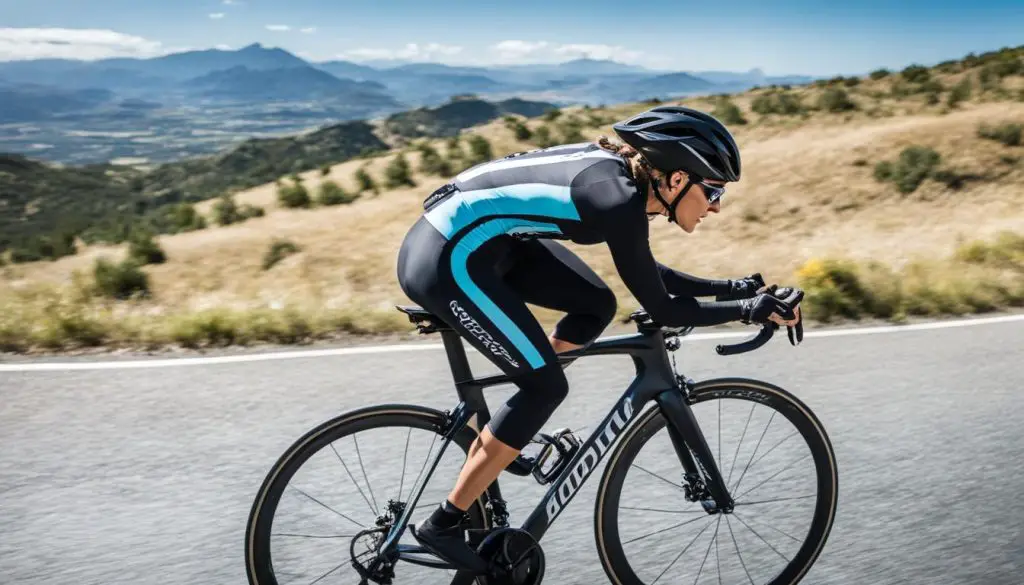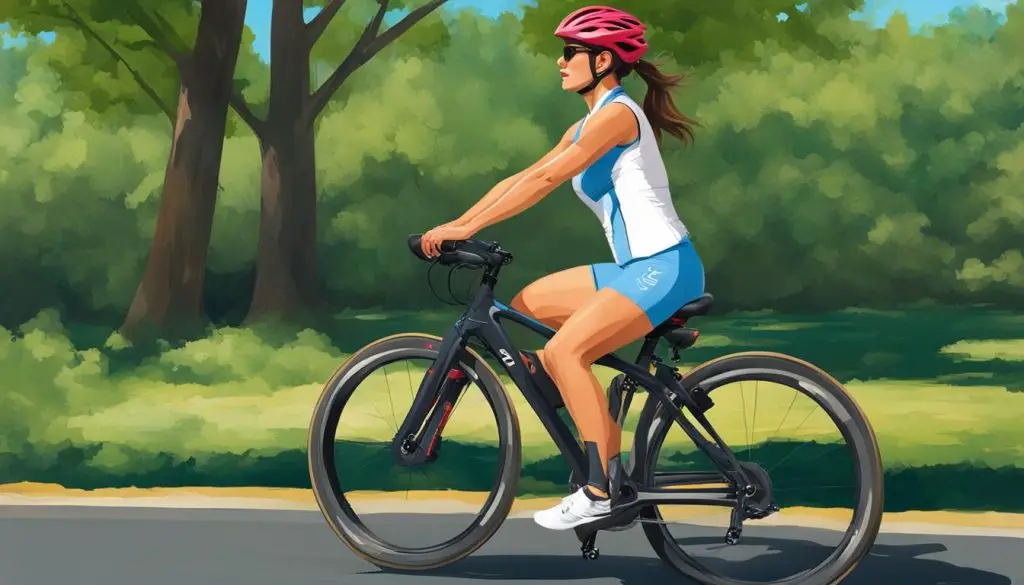Note that this post contains affiliate links and we may earn a small commission at no extra cost to you if you buy something.
When it comes to cycling, having the proper seating position is essential for women. Not only does it ensure comfort, but it also improves efficiency and minimizes the risk of pain or discomfort while riding. Maintaining a relaxed and balanced posture is key, focusing on areas such as the shoulders, elbows, wrists, spine, and knee alignment. By following these tips, women can optimize their sitting posture and enhance their overall cycling experience.
Key Takeaways:
- Pay attention to maintaining a relaxed and balanced posture while cycling.
- Focus on proper alignment of the shoulders, elbows, wrists, spine, and knees.
- Optimize comfort and efficiency by adjusting the bike fit to suit your body.
- Choose a saddle specifically designed for women’s anatomy to prevent discomfort.
- Consider seeking professional bike fitting assessments to resolve persistent discomfort.
The Importance of Body Positioning on a Road Bike
Body positioning is crucial for a successful cycling experience, especially when riding a road bike. As a woman cyclist, it is essential to pay attention to your body position to ensure comfort, avoid pain, and optimize performance.
Here are some key aspects of body position that every female road cyclist should consider:
Relaxed Shoulders for Minimizing Neck Pain
When cycling, it’s important to relax your shoulders and bring them down away from your ears. This helps maintain a relaxed posture and prevents unnecessary tension in your neck, minimizing the risk of neck pain.
Using Your Arms as Suspension
Bending your elbows and allowing your arms to act as suspension can help absorb impact while riding on uneven surfaces. This reduces strain on your shoulders and upper body, enhancing both comfort and control.
Straight Wrists for Reducing Strain
Keeping your wrists straight and aligned with your elbows is crucial in preventing strain and discomfort. Proper wrist alignment helps distribute pressure evenly and maximizes power transfer to the handlebars.
Engaging the Core for Proper Body Alignment
Engaging your core muscles is key to maintaining a neutral spine and proper body alignment. By activating your core, you can prevent slouching and excessive pressure on your hands, shoulders, and crotch, ultimately enhancing comfort and efficiency.
Maintaining Correct Knee Tracking
Aligning your knees over the balls of your feet or pedals is vital for optimal power transfer and reducing the risk of knee pain. Paying attention to correct knee tracking helps maintain alignment and maximize cycling efficiency.
By focusing on these aspects of body positioning, women can achieve a more comfortable and pain-free ride on their road bikes. Remember to listen to your body and make any necessary adjustments to optimize your riding experience.
Stay tuned for the next section, where we will explore the different hand positions on a road bike and their benefits.
Choosing the Right Hand Positions on a Road Bike
Road bikes offer various hand positions to cater to different riding situations. As a woman cyclist, it’s essential to understand the types of hand positions and their benefits. Here are the key hand positions to consider:
- Drops: Lowering your hands to the drops on the handlebar is perfect for downhill riding. This position helps lower the center of gravity, providing better balance and traction on the road.

- Hoods: Riding in the hoods is the most common hand position used during regular riding. It allows for easy access to the brake levers and shifting mechanisms while maintaining a relaxed riding position.
- Top of the bars: Placing your hands on top of the bars is suitable for long, steady climbs without traffic. It allows your body to sit upright, reducing strain on the back and providing comfort during extended ascents. However, it’s important to avoid this hand position during descents or in traffic as it reduces control over the bike.

By understanding the different hand positions and when to utilize them, you can enhance your riding experience and avoid numbness in your hands while cycling.
Understanding the Importance of Saddle Positioning
The position of the saddle on a bike is crucial, especially for women cyclists, as it can significantly affect comfort and prevent crotch pain. To ensure a comfortable and pain-free ride, consider the following factors when adjusting your saddle:
- Saddle height: Set the height so that there is a slight bend in your knee when the pedal is at its lowest position. This correct height distribution helps prevent knee pain and allows for efficient pedaling.
- Saddle tilt: Ensure that the saddle is level or slightly tilted, avoiding extreme angles. This prevents discomfort and sliding forward onto the narrow end of the saddle.
- Saddle fore/aft position: Pay attention to the alignment of the saddle in relation to your knees and pedals. It should be positioned to ensure optimal power transfer and to reduce pressure on the vulva. Finding the right balance is crucial for both comfort and efficiency.
- Saddle selection: Women often have wider sit bones compared to men, so it is important to choose a saddle specifically designed for women’s anatomy. Experiment with different saddle options to find one that feels comfortable and supports your unique anatomy.
By carefully adjusting your saddle position and selecting the right saddle, you can prevent crotch pain and enjoy a comfortable and pleasurable cycling experience. Remember, personalized adjustments are essential, as what works for one person may not work for another.
Proper saddle positioning is just one aspect of achieving optimal seating comfort on a bike. In the next section, we’ll explore the role of bike fit in enhancing your overall riding experience.
The Role of Bike Fit in Seating Comfort
Along with saddle positioning, the overall bike fit is another important aspect to consider for seating comfort. To ensure an enjoyable and pain-free ride, women should pay attention to the following factors:
- Frame size: Choosing the right frame size is crucial for optimal comfort and efficiency. Assessing your dimensions and considering your riding style are important when selecting the appropriate frame size.
- Handlebar alignment: Adjusting the handlebar height and reach to suit your torso and arm length is essential. This will allow for a slight bend at the elbows and help maintain a comfortable and balanced riding position.
- Considering professional fit assessments: If you experience persistent discomfort while cycling, it may be beneficial to consult a professional bike fitter or physical therapist. They can assess the overall fit of your bike and make necessary adjustments to resolve any issues.
- Troubleshooting discomfort factors: It’s important to be open to making changes and adjustments to your bike setup to address any discomfort factors. This may involve experimenting with different components such as stem lengths or handlebar types to find the optimal fit that suits your individual comfort.
By paying attention to bike fit and making necessary adjustments, women can ensure a comfortable and enjoyable ride, while minimizing the risk of discomfort and potential injuries.
Conclusion
Achieving seating comfort and an optimal body position is crucial for women cyclists to have an enjoyable and efficient ride. By focusing on proper body positioning, saddle adjustment, and personalized bike fit, women can enhance their cycling experience, minimize discomfort, and maximize their performance on the bike.
One of the key aspects of achieving seating comfort is the importance of proper body positioning. Women should pay attention to maintaining a relaxed and balanced posture, ensuring the alignment of key areas such as the shoulders, elbows, wrists, spine, and knees. By adopting the correct body position, women can ride with ease and prevent pain or discomfort during their cycling sessions.
Another crucial factor for seating comfort is the proper positioning of the saddle. Women should aim for the correct saddle height, tilt, and fore/aft position to minimize pressure on sensitive areas and prevent crotch pain. Choosing a saddle specifically designed for women’s anatomy can also make a significant difference in comfort, as women tend to have wider sit bones compared to men.
Lastly, personalized bike fit plays an important role in achieving optimal seating comfort. Adjusting the bike frame to suit individual comfort, assessing frame size, handlebar alignment, and seeking professional bike fit assessments when needed are vital steps in finding the perfect fit. Troubleshooting discomfort factors and experimenting with different components can help women fine-tune their seating position and enhance their overall cycling experience.
Remember, by prioritizing seating comfort and incorporating these tips into your cycling routine, you can enjoy every ride to the fullest. Take the time to optimize your body position, saddle adjustment, and bike fit for a smooth and enjoyable biking experience. Happy cycling!
Source Links
- https://bike.bikegremlin.com/360/setting-up-riding-position-bike-fitting/
- https://www.liv-cycling.com/global/campaigns/proper-body-position-on-a-road-bike/20716
- https://www.adventurecycling.org/blog/make-it-fit-saddle-adjustments-for-women/
Andrew Hansen is a seasoned cyclist and fitness enthusiast dedicated to promoting a healthier lifestyle through stationary exercise biking. With over two decades of experience in the cycling world, Andrew has covered countless trails globally, bringing a wealth of knowledge to his role as the founder and primary writer at Life Fitness Bike.
Andrew’s passion lies in stationary exercise biking, and he is committed to providing comprehensive resources for cycling enthusiasts of all levels. His articles are not only informative but also reflect the joy and fitness benefits that stationary cycling brings. As the driving force behind Life Fitness Bike, Andrew wears many hats—founder, writer, and expert in the field—making him a valuable guide for individuals seeking to make the most of their stationary exercise cycling experience.


